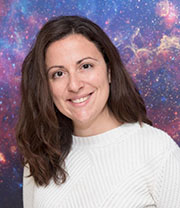How to Tackle a Giant Star: Multi-Wavelength Studies of Cool, Evolved Stars Using HST and VLTI
Gioia Rau
NASA Goddard Space Flight Center
Wed, February 6,, 2019 - 4:00 PM
Karl Herzfeld Auditorium of Hannan Hall - Rm 108
 The chemical enrichment of the Universe is considerably affected by the contributions of Giant stars. K-M giant and supergiant stars are surrounded by a hot layer called the chromosphere, which likely powers Magneto-Hydrodynamic Alfven waves that drive their mass loss. Toward the end of their life, on the Asymptotic Giant Branch (AGB), stars produce heavy chemical elements, molecules, and dust, which, through the mass loss provided via their stellar winds, are placed into the interstellar medium.
The chemical enrichment of the Universe is considerably affected by the contributions of Giant stars. K-M giant and supergiant stars are surrounded by a hot layer called the chromosphere, which likely powers Magneto-Hydrodynamic Alfven waves that drive their mass loss. Toward the end of their life, on the Asymptotic Giant Branch (AGB), stars produce heavy chemical elements, molecules, and dust, which, through the mass loss provided via their stellar winds, are placed into the interstellar medium.
This talk will explore ongoing work modeling high-resolution spectroscopic observations with Hubble Space Telescope instruments (Rau et al. 2018, subm.), to reveal the role of the chromosphere in driving K-M giant and supergiant winds. Our results include estimates of wind and chromospheric parameters, mass-loss rates, and fundamental stellar parameters.
In addition, ground-based interferometric measurements with high-angular resolution instruments from VLTI, such as MIDI (Rau et al. 2015, Rau et al. 2017) and GRAVITY (Wittkowski et al. 2018), helped to test geometrical and dynamical models describing the behavior of the outer AGB atmospheres at various spatial scales. In this way we are able to unravel the role of molecules and dust in their extended atmospheres.
Future plans include the use of high-angular resolution instruments such as VEGA at CHARA, and MATISSE at VLTI, to better understand the behavior of cool stars outer atmospheres at various spatial scales.
Refreshments served at 3:45 PM
If you have any questions about the Colloquium Series or would like to make a donation please contact Adrienne Black, black@cua.edu or (202) 319-5315.
